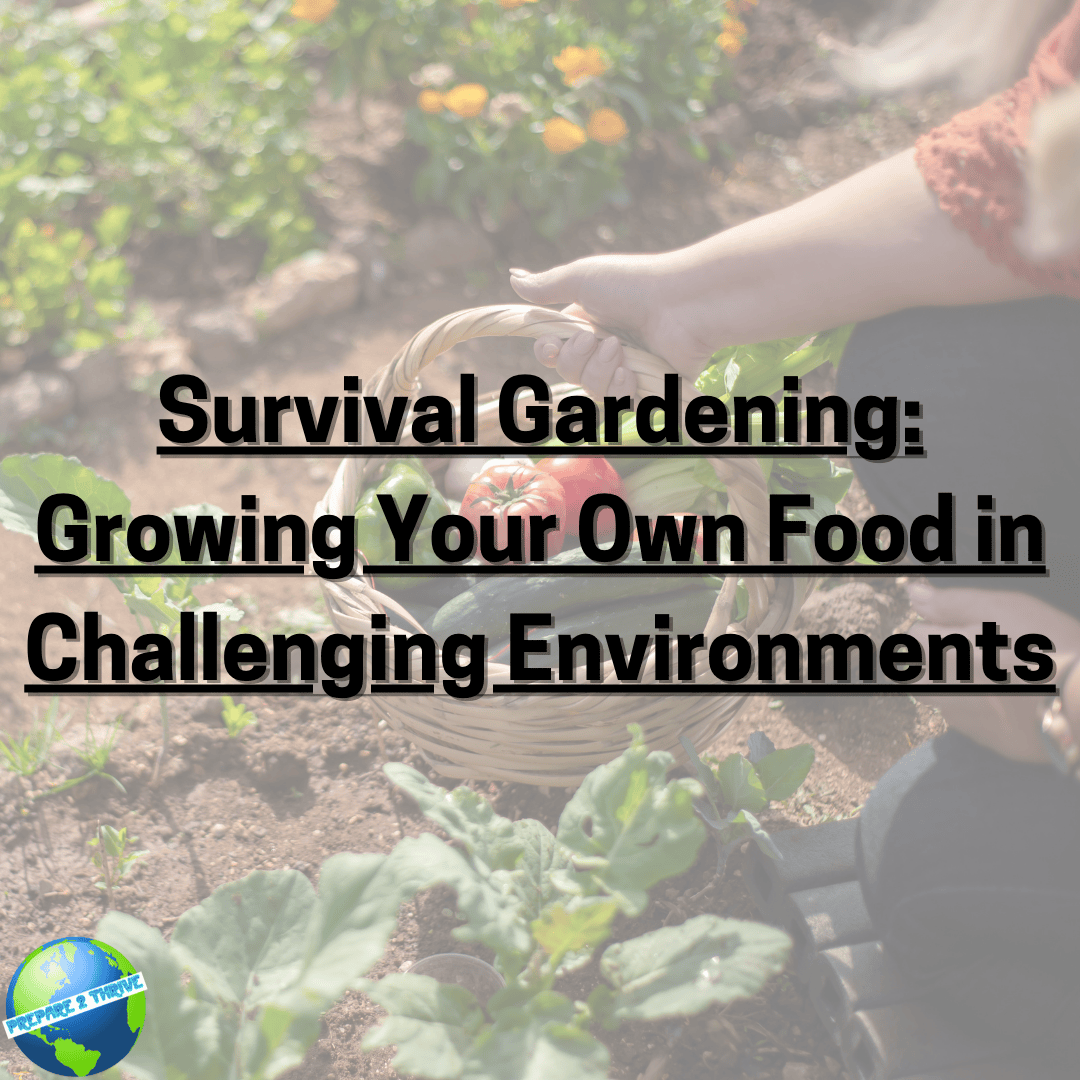I. Introduction
In an increasingly uncertain world, self-sufficiency and the ability to sustain oneself have become paramount. One crucial aspect of self-sufficiency is food production. Growing your own food not only provides a sense of empowerment and independence but also ensures a steady supply of fresh, nutritious produce, especially in challenging environments. This is where the concept of survival gardening comes into play.
A. Importance of self-sufficiency in food production
In today's fast-paced and interconnected world, we have become heavily reliant on complex global food systems. However, these systems can be vulnerable to disruptions such as natural disasters, economic crises, or even pandemics. Developing self-sufficiency in food production acts as a safeguard against such uncertainties, allowing individuals and communities to have a reliable source of nourishment even in challenging times.
B. Challenges of growing food in challenging environments
Many regions face unique environmental challenges that can make traditional gardening methods difficult. These challenges may include extreme weather conditions, limited access to water, poor soil quality, or a lack of space. However, rather than seeing these challenges as obstacles, they can be viewed as opportunities to adapt and find innovative solutions through survival gardening.
C. The concept of survival gardening
Survival gardening is a holistic approach to food production that focuses on cultivating resilient plants, implementing smart garden design, employing sustainable practices, and planning for long-term self-sufficiency. It involves utilizing available resources efficiently, maximizing yields in limited spaces, and adapting to specific environmental conditions. By embracing survival gardening techniques, individuals can overcome the limitations of challenging environments and take control of their food security.
In the following sections, we will delve into the various aspects of survival gardening, providing practical tips and techniques for growing your own food in challenging environments. From assessing your environment to choosing the right plants, implementing smart garden design, dealing with pests and diseases, and extending the growing season, we will explore strategies to help you cultivate a thriving survival garden. Let's embark on this journey to discover the rewards of self-sufficiency and the satisfaction of growing your own food, no matter the challenges you may face.
II. Assessing Your Environment
Before embarking on your survival gardening journey, it is crucial to assess your environment thoroughly. Understanding the unique characteristics of your location will help you make informed decisions about the types of crops to grow and the gardening techniques to employ.
A. Understanding your climate and weather patterns
Climate plays a significant role in determining the success of your garden. Take time to research the average temperatures, precipitation levels, and seasonal variations in your area. This knowledge will help you choose crops that are well-suited to your climate. For example, if you live in a region with short growing seasons and cold winters, focus on cold-hardy crops that can withstand frost.
B. Evaluating soil quality and composition
Soil is the foundation of a thriving garden, so it's important to assess its quality and composition. Conduct a soil test to determine its pH level, nutrient content, and drainage capacity. This information will guide you in making any necessary amendments to improve soil fertility and structure. In challenging environments with poor soil, consider container gardening or raised beds filled with high-quality soil mixtures.
C. Assessing available sunlight and shade
The amount of sunlight your garden receives is crucial for plant growth. Observe the sunlight patterns in your garden throughout the day and identify areas with full sun, partial shade, or full shade. Different crops have varying sunlight requirements, so plan your garden layout accordingly. Tall structures or nearby trees may cast shadows, which can be used strategically to protect delicate plants from excessive heat or to create microclimates for shade-loving crops.
By thoroughly assessing your environment, you will gain valuable insights into its unique characteristics and limitations. This knowledge will enable you to make informed decisions about plant selection, garden design, and cultivation techniques that are best suited to your specific environment. In the next section, we will explore the importance of choosing the right plants for survival gardening.
III. Selecting Hardy Plant Varieties
Selecting the appropriate plants for survival gardening is essential to ensure successful growth and a bountiful harvest. When faced with challenging environments, it is crucial to choose crops that are hardy, resilient, and well-adapted to your specific conditions. Here are some key considerations when selecting plants for your survival garden:
A. Hardy and resilient plant varieties
Look for plant varieties that have a reputation for being robust and resilient. These plants can withstand various environmental stresses, such as extreme temperatures, drought, or poor soil conditions. Examples of hardy crops include kale, Swiss chard, root vegetables like carrots and radishes, and herbs like rosemary and thyme. Additionally, consider heirloom varieties and open-pollinated seeds, as they often exhibit greater adaptability.
B. Selecting crops suited to your environment
Take into account the specific challenges of your environment and choose crops that are well-suited to those conditions. For example, if you live in an arid region with limited water availability, opt for drought-tolerant plants like succulents, cacti, or Mediterranean herbs such as lavender or oregano. If you have a short growing season, focus on fast-maturing varieties of vegetables and fruits that can reach maturity within a limited timeframe.
C. Considering fast-maturing crops for quick harvests
In challenging environments, where conditions may not be optimal for long growing seasons, prioritizing fast-maturing crops allows you to enjoy quicker harvests. Look for varieties that have shorter maturity times, enabling you to reap the rewards of your labor sooner. Leafy greens like lettuce, spinach, and arugula, as well as radishes and bush beans, are excellent choices for rapid growth and harvest.
When choosing plants for your survival garden, it is important to strike a balance between crops that can thrive in challenging conditions and those that meet your dietary preferences and nutritional needs. Consider the climate, soil quality, and available resources, and select plants that have a high likelihood of success in your specific environment. In the next section, we will explore smart garden design techniques that can further enhance the productivity of your survival garden.
IV. Smart Garden Design
Smart garden design is a key component of survival gardening, especially in challenging environments. By implementing intelligent design techniques, you can maximize space, optimize resource utilization, and create a favorable environment for your plants to thrive. Here are some essential aspects to consider when designing your survival garden:
A. Utilizing vertical gardening and raised beds
In environments where space is limited, vertical gardening and raised beds are effective strategies for maximizing growing areas. Vertical gardening involves growing plants vertically, utilizing structures such as trellises, arbors, or hanging containers. This method is ideal for vining crops like tomatoes, cucumbers, and beans. Raised beds offer improved soil drainage, increased control over soil quality, and reduced weed competition. They are particularly beneficial in areas with poor soil conditions.
B. Incorporating companion planting for pest control
Companion planting involves growing compatible plant species together to enhance growth, deter pests, and improve overall garden health. Some plants naturally repel pests or attract beneficial insects that help control garden pests. For instance, planting marigolds alongside tomatoes can deter nematodes, while growing basil near peppers can repel aphids. Research companion planting combinations suitable for your chosen crops to promote a balanced and pest-resistant garden ecosystem.
C. Making use of microclimates and windbreaks
Understanding the microclimates within your garden can help you create favorable growing conditions for different plants. Certain areas may be warmer or cooler, more sheltered, or exposed to wind. Take advantage of these microclimates by placing heat-loving plants in sunnier spots and positioning more delicate plants in areas protected from strong winds. You can also utilize natural or artificial windbreaks, such as fences, hedgerows, or tall plantings, to shield your garden from harsh winds and prevent excessive drying of the soil.
By incorporating smart garden design techniques, you can make the most of your available space, optimize growing conditions, and improve the overall productivity of your survival garden. Vertical gardening and raised beds enable efficient use of space, companion planting enhances pest control, and strategic utilization of microclimates and windbreaks creates a favorable growing environment. In the next section, we will discuss watering and irrigation techniques to ensure your survival garden receives adequate moisture in challenging environments.
V. Watering and Irrigation Techniques
Water is a precious resource, especially in challenging environments where it may be scarce or limited. Proper watering and irrigation techniques are essential for the success of your survival garden. By employing efficient water management strategies, you can ensure that your plants receive adequate moisture while conserving this valuable resource. Consider the following techniques for watering and irrigation in challenging environments:
A. Collecting and conserving rainwater
Rainwater harvesting is an effective method to supplement your water supply. Set up rain barrels or storage tanks to collect rainwater from roofs or other suitable surfaces. This collected water can then be used to irrigate your garden during dry periods. Implementing guttering systems and diverting downspouts towards your water storage containers will help maximize water collection.
B. Drip irrigation and efficient watering systems
Drip irrigation is a water-efficient method that delivers water directly to the plant roots, minimizing evaporation and reducing water waste. Set up a drip irrigation system with emitters or soaker hoses that can be placed near the plants' base. This method ensures targeted watering and prevents water loss through overspray or runoff. Additionally, consider using timers or moisture sensors to automate and optimize watering schedules based on your plants' needs.
C. Mulching to retain moisture and reduce evaporation
Mulching is a valuable technique for conserving soil moisture and reducing water evaporation. Apply a layer of organic mulch, such as straw, wood chips, or compost, around the base of your plants. This protective layer helps to retain soil moisture, suppresses weed growth, and regulates soil temperature. Mulching also improves soil structure over time, enhancing its water-holding capacity and reducing the frequency of watering.
By implementing water-efficient techniques such as rainwater harvesting, drip irrigation, and mulching, you can optimize water usage and ensure your survival garden receives adequate moisture in challenging environments. Conserving water not only helps sustain your garden but also promotes responsible resource management. In the next section, we will explore strategies for dealing with pests and diseases, which can pose significant challenges in survival gardening.
VI. Dealing with Pests and Diseases
Pests and diseases can wreak havoc on a survival garden, posing a significant threat to your food production efforts. In challenging environments, where plants may already be under stress, it becomes even more crucial to implement effective pest and disease management strategies. Here are some natural and organic approaches to help you maintain a healthy and thriving garden:
A. Natural pest control methods
Embrace natural pest control methods to minimize the use of synthetic pesticides and protect beneficial insects. Encourage biodiversity in your garden by planting a variety of flowers, herbs, and vegetables that attract beneficial insects like ladybugs, lacewings, and bees. These insects can prey on harmful pests, keeping their populations in check. Additionally, practice handpicking pests off plants, use physical barriers like row covers or netting to exclude pests, and consider introducing beneficial nematodes or predatory insects for targeted pest control.
B. Organic approaches to managing common garden diseases
Prevention is key when it comes to managing garden diseases organically. Start by selecting disease-resistant plant varieties whenever possible. Proper plant spacing and good airflow help reduce humidity levels, which can discourage the growth of fungal diseases. Additionally, practice crop rotation, avoid overhead watering, and promptly remove and dispose of any infected plants or plant parts to prevent the spread of diseases.
C. Protecting your plants from wildlife and larger pests
Wildlife and larger pests, such as rabbits, deer, or birds, can cause substantial damage to your survival garden. Implement physical deterrents like fences, netting, or scare devices to protect your plants. For small mammals, consider creating barriers by burying wire mesh around the perimeter of your garden. For birds, use reflective tape or install bird netting over vulnerable crops. Additionally, planting sacrificial crops or creating wildlife-friendly habitats away from your garden can help redirect their attention and minimize damage.
By employing natural pest control methods, implementing organic disease management techniques, and protecting your plants from wildlife and larger pests, you can mitigate the impact of pests and diseases in your survival garden. These approaches promote a balanced and harmonious ecosystem within your garden, reducing reliance on harmful chemicals and fostering the long-term health and productivity of your plants. In the next section, we will explore techniques for extending the growing season, enabling you to maximize your food production efforts.
VII. Extending the Growing Season
Extending the growing season is a valuable strategy in survival gardening, especially in challenging environments with limited growing periods. By utilizing various techniques, you can prolong the productive life of your garden and enjoy fresh produce for an extended period. Here are some effective methods to extend the growing season:
A. Using greenhouses and cold frames
Greenhouses and cold frames provide controlled environments that protect plants from harsh weather conditions and extend the growing season. These structures trap heat from the sun, creating a warmer microclimate for your plants. Consider investing in a greenhouse or constructing a DIY cold frame using transparent materials like glass or plastic. These structures allow you to start seeds earlier in the season, protect tender plants from frost, and grow heat-loving crops well into the cooler months.
B. Employing row covers and cloches
Row covers and cloches are temporary protective covers that shield plants from cold temperatures, wind, and pests. Row covers are made of lightweight fabrics, while cloches are individual covers placed over individual plants. These covers act as insulators, retaining heat and creating a mini-greenhouse effect around your plants. Use them during cooler nights or transitional seasons to safeguard sensitive crops and promote their growth and productivity.
C. Understanding season extension techniques
Familiarize yourself with season extension techniques such as succession planting, intercropping, and using frost-tolerant varieties. Succession planting involves sowing seeds or transplanting seedlings at staggered intervals, ensuring a continuous supply of fresh produce throughout the growing season. Intercropping involves planting compatible crops together, maximizing space and optimizing resource utilization. Additionally, selecting frost-tolerant varieties allows you to extend the growing season into cooler periods.
By implementing techniques like greenhouses, cold frames, row covers, and season extension methods, you can stretch the boundaries of your growing season and maximize your food production efforts. These techniques provide additional time for plants to mature, yield more crops, and contribute to a more sustainable and self-sufficient survival garden. In the next section, we will explore harvesting and storing your yield, ensuring that your hard work pays off in the long run.
VIII. Harvesting and Storing Your Yield
The culmination of your survival gardening efforts is the bountiful harvest of fresh, homegrown produce. Proper harvesting and storing techniques are crucial to maximize the shelf life and nutritional value of your yield. Here are some guidelines to ensure you make the most of your hard-earned harvest:
A. Harvesting at the right time
Harvest crops at their peak of ripeness to enjoy the best flavor and nutritional content. Different crops have different indicators for readiness, such as color, texture, or size. Consult seed packets or gardening resources for specific guidance on each plant variety. Use sharp, clean tools to harvest fruits, vegetables, and herbs, and handle them gently to prevent damage. Harvest regularly to promote continuous production and prevent plants from becoming overripe or going to seed.
B. Proper post-harvest handling
Handle harvested produce with care to avoid bruising or damage. Remove any excess dirt, insects, or debris from the harvested plants. For leafy greens and herbs, remove any yellowed or damaged leaves. Avoid washing fruits and vegetables unless necessary, as excess moisture can lead to spoilage. Instead, store them in cool, dry conditions to maintain freshness. If washing is required, ensure that the produce is thoroughly dried before storage.
C. Storage techniques for long-term use
Explore various storage methods to extend the shelf life of your harvest. Some crops, like root vegetables and winter squash, can be stored in a cool, dark, and well-ventilated area for several months. Others, like herbs, can be dried by hanging them upside down in a warm, well-ventilated space. Consider canning, freezing, or preserving excess produce through methods like pickling or fermenting. Properly labeling and organizing stored items will help you keep track of inventory and ensure nothing goes to waste.
Remember to regularly inspect stored produce and promptly remove any items showing signs of spoilage or deterioration. By adopting proper harvesting and storage practices, you can enjoy the fruits of your labor for an extended period, promoting self-sufficiency and reducing dependence on external food sources.
IX. Planning for the Future
Survival gardening is not just about meeting immediate food needs; it is also about planning for the future and ensuring long-term sustainability. As you cultivate your survival garden, it is essential to consider strategies that promote ecological balance, resource conservation, and adaptability to changing conditions. Here are some key aspects to focus on when planning for the future of your survival garden:
A. Sustainable gardening practices
Embrace sustainable gardening practices that minimize environmental impact and maximize resource efficiency. Implement organic gardening techniques, such as composting, to enrich the soil naturally and reduce the need for synthetic fertilizers. Practice water conservation by utilizing efficient irrigation methods and collecting rainwater. Choose open-pollinated or heirloom seed varieties to promote biodiversity and preserve genetic diversity. By prioritizing sustainability, you contribute to the long-term health and resilience of your garden ecosystem.
B. Seed saving and crop rotation
Seed saving is an important skill that allows you to preserve and propagate plant varieties adapted to your specific environment. Learn how to properly collect, store, and sow seeds from your own plants. This practice not only saves money but also helps maintain a diverse seed bank for future generations. Additionally, practice crop rotation to prevent soil depletion and control pests and diseases. Rotate crops within different plant families to maintain soil fertility and minimize the buildup of specific pathogens or pests.
C. Adaptation to changing conditions
Recognize that environmental conditions may evolve over time, and adaptability is key to the success of your survival garden. Stay informed about climate patterns, pest outbreaks, and other factors that may impact your garden. Be open to trying new plant varieties that are better suited to changing conditions. Consider implementing techniques such as shade structures or mulching to mitigate the effects of temperature extremes. By remaining flexible and responsive to changing circumstances, you increase the likelihood of long-term success.
D. Community collaboration and knowledge sharing
Engage with your local community and like-minded individuals to foster collaboration and knowledge sharing. Join gardening groups, participate in workshops, or start a community garden where resources and experiences can be shared. Collaborating with others allows you to learn from their expertise, exchange seeds and plants, and build a supportive network. By working together, you can strengthen your collective resilience and expand your gardening capabilities.
By focusing on sustainability, seed saving, crop rotation, adaptation, and community collaboration, you can plan for the future of your survival garden with resilience and foresight. Continually assess and refine your gardening practices to ensure they align with the changing needs of both your garden and the environment. By doing so, you create a foundation for sustained food production, self-sufficiency, and environmental stewardship.
X. Conclusion: Nurturing Resilience Through Survival Gardening
Survival gardening is not only about growing your own food in challenging environments; it is a journey of resilience, self-sufficiency, and empowerment. By cultivating a survival garden, you are taking control of your food supply, reducing reliance on external sources, and embracing the power of nature to sustain you in times of adversity.
Throughout this article, we have explored the key aspects of survival gardening, from selecting hardy plant varieties to implementing smart garden design, efficient watering techniques, pest and disease management, extending the growing season, and proper harvesting and storage practices. Each of these elements contributes to your ability to thrive in challenging environments and maximize your food production efforts.
Survival gardening is not without its challenges, but it provides numerous benefits. It connects you with the natural world, promotes self-sufficiency, improves food security, and offers a sense of fulfillment and accomplishment. It also enables you to prioritize fresh, nutritious, and organic produce, enhancing your overall well-being.
As you embark on your survival gardening journey, remember to be adaptable and willing to learn from both successes and setbacks. Experiment with different plant varieties and techniques that work best for your specific environment. Embrace the opportunity to grow not just food but also your knowledge, skills, and resilience.
So, whether you find yourself in a desert landscape, a high-altitude region, or an urban environment with limited space, know that survival gardening can thrive anywhere with the right approach. Cultivate your garden with care, patience, and determination, and witness the transformation of your surroundings into a sanctuary of abundance and sustenance.
In the face of uncertain times, nurturing resilience through survival gardening empowers you to take charge of your own well-being and create a more sustainable future. Start today, and let your survival garden be a testament to the strength of the human spirit and the resilience of nature.
Hashtags: #SurvivalGardening #SelfSufficiency #Resilience #GrowYourOwnFood #ChallengingEnvironments #GardenDesign #WateringTechniques #PestManagement #SeasonExtension #Harvesting #Storing #SustainableGardening #Adaptability #CommunityCollaboration #FuturePlanning







